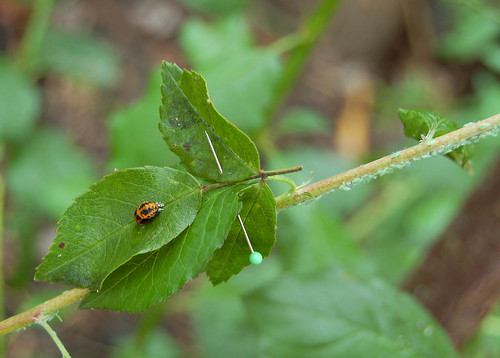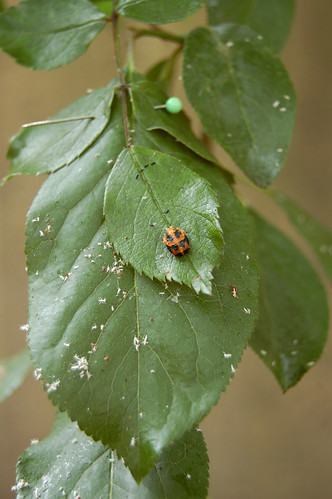It's a bug eat bug world
...

Our little East Oakland garden has aphids. Lots and lots of aphids. The plum trees are being particularly hard-hit. The young leaves look really tortured.
I was struck by a particularly crazy idea, and harvested some rose leaves from my West Oakland garden, and pinned them on to various leaves in the corner of the garden with the worst aphid infestation.
The leaves were the home of lady beetle pupae. If all goes well, these will transform into the familiar ladybug. (The larval stage, which is the real aphid predator, is even more freaky-looking. They're like tiny alligators, or horny toads.) The ladybugs may feast on aphids, and establish themselves in my garden.
I know that you can buy ladybugs by the hundreds, but that somehow doesn't suit my temperament. It seems wrong (to my mind) to import bugs from who-knows-where to fight a local garden pest. There are so many stories about an animal being introduced to an ecosystem, and becoming a rampant pest instead of serving the purpose that Man had in mind. The mongoose in Hawaii is a good example. The rabbits in Australia. The eucalyptus in California. Kudzu in the American South.
I may be driving some ladybugs a few miles, from one end of Oakland to the other, but that's as far as I'll go. And for all I know, these are the invasive Asian lady beetles that have become a nuisance. If I've spread those across Oakland, I'm going straight to Hell, where I'll hang out with the other hypocrites.

There's lots to say about ladybugs (or ladybirds, or lady beetles), but I'm zonked out from seasonal allergies, and am feeling too indolent to write a treatise on them.
If you are interested in what's called Citizen Science, you should check out the Lost Ladybug Project. Using photos taken by interested Americans, it tracks the population changes of ladybugs in the United States.

Our little East Oakland garden has aphids. Lots and lots of aphids. The plum trees are being particularly hard-hit. The young leaves look really tortured.
I was struck by a particularly crazy idea, and harvested some rose leaves from my West Oakland garden, and pinned them on to various leaves in the corner of the garden with the worst aphid infestation.
The leaves were the home of lady beetle pupae. If all goes well, these will transform into the familiar ladybug. (The larval stage, which is the real aphid predator, is even more freaky-looking. They're like tiny alligators, or horny toads.) The ladybugs may feast on aphids, and establish themselves in my garden.
I know that you can buy ladybugs by the hundreds, but that somehow doesn't suit my temperament. It seems wrong (to my mind) to import bugs from who-knows-where to fight a local garden pest. There are so many stories about an animal being introduced to an ecosystem, and becoming a rampant pest instead of serving the purpose that Man had in mind. The mongoose in Hawaii is a good example. The rabbits in Australia. The eucalyptus in California. Kudzu in the American South.
I may be driving some ladybugs a few miles, from one end of Oakland to the other, but that's as far as I'll go. And for all I know, these are the invasive Asian lady beetles that have become a nuisance. If I've spread those across Oakland, I'm going straight to Hell, where I'll hang out with the other hypocrites.

There's lots to say about ladybugs (or ladybirds, or lady beetles), but I'm zonked out from seasonal allergies, and am feeling too indolent to write a treatise on them.
If you are interested in what's called Citizen Science, you should check out the Lost Ladybug Project. Using photos taken by interested Americans, it tracks the population changes of ladybugs in the United States.

Comments
I don't know how you feel about organic insecticides, but my mom uses this soap in her herb garden...It is approved for organic use and really takes care of the aphids.
http://www.planetnatural.com/site/insecticidal-soap.html
I'm disinclined to apply insecticides, because I worry about their effects on the bees and butterflies.
Zoemomma
My personal discomfort with mail-order ladybugs comes from the fact that there has been such a radical shift in the population distributions of ladybugs in the United States. I'm uncomfortable adding to this disruption of nature.
But, that's just me.